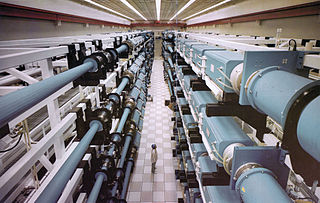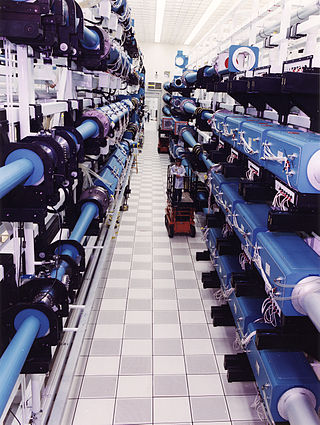
Inertial confinement fusion (ICF) is a fusion energy process that initiates nuclear fusion reactions by compressing and heating targets filled with fuel. The targets are small pellets, typically containing deuterium (2H) and tritium (3H).

Fusion power is a proposed form of power generation that would generate electricity by using heat from nuclear fusion reactions. In a fusion process, two lighter atomic nuclei combine to form a heavier nucleus, while releasing energy. Devices designed to harness this energy are known as fusion reactors. Research into fusion reactors began in the 1940s, but as of 2023, no device has reached net power.
This timeline of nuclear fusion is an incomplete chronological summary of significant events in the study and use of nuclear fusion.

The National Ignition Facility (NIF) is a laser-based inertial confinement fusion (ICF) research device, located at Lawrence Livermore National Laboratory in Livermore, California, United States. NIF's mission is to achieve fusion ignition with high energy gain. It achieved the first instance of scientific breakeven controlled fusion in an experiment on December 5, 2022, with an energy gain factor of 1.5. It supports nuclear weapon maintenance and design by studying the behavior of matter under the conditions found within nuclear explosions.
The Laboratory for Laser Energetics (LLE) is a scientific research facility which is part of the University of Rochester's south campus, located in Brighton, New York. The lab was established in 1970 with operations jointly funded by the United States Department of Energy, the University of Rochester and the New York State government. The Laser Lab was commissioned to investigate high-energy physics involving the interaction of extremely intense laser radiation with matter. Scientific experiments at the facility emphasize inertial confinement, direct drive, laser-induced fusion, fundamental plasma physics and astrophysics using the Omega Laser Facility. In June 1995, OMEGA became the world's highest-energy ultraviolet laser. The lab shares its building with the Center for Optoelectronics and Imaging and the Center for Optics Manufacturing. The Robert L. Sproull Center for Ultra High Intensity Laser Research was opened in 2005 and houses the OMEGA EP laser, which was completed in May 2008.

A krypton fluoride laser is a particular type of excimer laser, which is sometimes called an exciplex laser. With its 248 nanometer wavelength, it is a deep ultraviolet laser which is commonly used in the production of semiconductor integrated circuits, industrial micromachining, and scientific research. The term excimer is short for 'excited dimer', while exciplex is short for 'excited complex'. An excimer laser typically contains a mixture of: a noble gas such as argon, krypton, or xenon; and a halogen gas such as fluorine or chlorine. Under suitably intense conditions of electromagnetic stimulation and pressure, the mixture emits a beam of coherent stimulated radiation as laser light in the ultraviolet range.

The Shiva laser was a powerful 20-beam infrared neodymium glass laser built at Lawrence Livermore National Laboratory in 1977 for the study of inertial confinement fusion (ICF) and long-scale-length laser-plasma interactions. Presumably, the device was named after the multi-armed form of the Hindu god Shiva, due to the laser's multi-beamed structure. Shiva was instrumental in demonstrating a particular problem in compressing targets with lasers, leading to a major new device being constructed to address these problems, the Nova laser.

Nova was a high-power laser built at the Lawrence Livermore National Laboratory (LLNL) in California, United States, in 1984 which conducted advanced inertial confinement fusion (ICF) experiments until its dismantling in 1999. Nova was the first ICF experiment built with the intention of reaching "ignition", a chain reaction of nuclear fusion that releases a large amount of energy. Although Nova failed in this goal, the data it generated clearly defined the problem as being mostly a result of Rayleigh–Taylor instability, leading to the design of the National Ignition Facility, Nova's successor. Nova also generated considerable amounts of data on high-density matter physics, regardless of the lack of ignition, which is useful both in fusion power and nuclear weapons research.

Inertial Fusion Energy is a proposed approach to building a nuclear fusion power plant based on performing inertial confinement fusion at industrial scale. This approach to fusion power is still in a research phase. ICF first developed shortly after the development of the laser in 1960, but was a classified US research program during its earliest years. In 1972, John Nuckolls wrote a paper predicting that compressing a target could create conditions where fusion reactions are chained together, a process known as fusion ignition or a burning plasma. On August 8, 2021, the NIF at Livermore National Laboratory became the first ICF facility in the world to demonstrate this. This breakthrough drove the US Department of Energy to create an Inertial Fusion Energy program in 2022 with a budget of 3 million dollars in its first year.

Argus was a two-beam high power infrared neodymium doped silica glass laser with a 20 cm (7.9 in) output aperture built at Lawrence Livermore National Laboratory in 1976 for the study of inertial confinement fusion. Argus advanced the study of laser-target interaction and paved the way for the construction of its successor, the 20 beam Shiva laser.

Cyclops was a high-power laser built at the Lawrence Livermore National Laboratory (LLNL) in 1975. It was the second laser constructed in the lab's Laser program, which aimed to study inertial confinement fusion (ICF).

Novette was a two beam neodymium glass testbed laser built at Lawrence Livermore National Laboratory in about 15 months throughout 1981 and 1982 and was completed in January 1983. Novette was made using recycled parts from the dismantled Shiva and Argus lasers and borrowed parts from the future Nova laser. Its main intended purpose was to validate the proposed design and expected performance of the then planned Nova laser. In addition to being used for the further study of enhanced laser to target plasma energy coupling utilizing frequency tripled light and examining its benefits with respect to inertial confinement fusion, Novette was also used in the world's first laboratory demonstration of an x-ray laser in 1984.
The Long Path laser was an early high energy infrared laser at the Lawrence Livermore National Laboratory used to study inertial confinement fusion. Long path was completed in 1972 and was the first ICF laser ever to use neodymium doped glass as the lasing medium. It was capable of delivering about 50 joules of light at 1,062 nm onto a target in ~10 ns pulses. It did not use spatial filters to smooth the beam after amplification stages and thus had a fairly poor beam quality. Long path was mostly used to investigate laser energy absorption in deuterated plastic targets.

The High Power laser Energy Research facility (HiPER), is a proposed experimental laser-driven inertial confinement fusion (ICF) device undergoing preliminary design for possible construction in the European Union. As of 2019, the effort appears to be inactive.
Fusion ignition is the point at which a nuclear fusion reaction becomes self-sustaining. This occurs when the energy being given off by the reaction heats the fuel mass more rapidly than it cools. In other words, fusion ignition is the point at which the increasing self-heating of the nuclear fusion removes the need for external heating. This is quantified by the Lawson criterion. Ignition can also be defined by the fusion energy gain factor.

LIFE, short for Laser Inertial Fusion Energy, was a fusion energy effort run at Lawrence Livermore National Laboratory between 2008 and 2013. LIFE aimed to develop the technologies necessary to convert the laser-driven inertial confinement fusion concept being developed in the National Ignition Facility (NIF) into a practical commercial power plant, a concept known generally as inertial fusion energy (IFE). LIFE used the same basic concepts as NIF, but aimed to lower costs using mass-produced fuel elements, simplified maintenance, and diode lasers with higher electrical efficiency.
Dmitri Dmitriyevich Ryutov is a Russian theoretical plasma physicist.
Heavy ion fusion is a fusion energy concept that uses a stream of high-energy ions from a particle accelerator to rapidly heat and compress a small pellet of fusion fuel. It is a subclass of the larger inertial confinement fusion (ICF) approach, replacing the more typical laser systems with an accelerator.
The history of nuclear fusion began early in the 20th century as an inquiry into how stars powered themselves and expanded to incorporate a broad inquiry into the nature of matter and energy, as potential applications expanded to include warfare, energy production and rocket propulsion.












